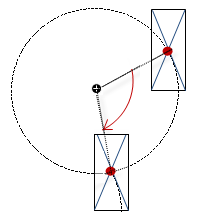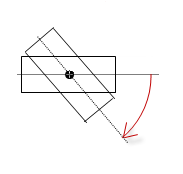Symbol:

Category: “Measurement Controls”
The element displays the value of a variable. The needle is positioned according to the value of the assigned variable on a scale. A meter is used to represent a tachometer, for example.
Element properties
|
“Element name” |
Example: |
|
“Type of element” |
“Meter 180°” |
|
“Value” |
Variable (numeric data type) The variable value determines the pointer direction of the element. |
Element property 'Center'
The properties contain fixed values for the coordinates of the point of rotation.
This point of rotation is shown as the  symbol. The point is used as the center for rotating and scaling.
symbol. The point is used as the center for rotating and scaling.
|
“X” |
X-coordinate of the point of rotation |
|
“Y” |
Y-coordinate of the point of rotation |
You can also change the values by dragging the symbols ( ) to other positions in the editor.
) to other positions in the editor.
These properties are available only when you have selected the “Support client animations and overlay of native elements” option in the Visualization Manager.
|
“Animation duration” |
Defines the duration (in milliseconds) in which the element runs an animation
Animatable properties
The animated movement is executed when at least one value of an animatable property has changed. The movement then executed is not jerky, but is smooth within the specified animation duration. The visualization element travels to the specified position while rotating dynamically. The transitions are smooth. |
|
“Move to foreground” |
Moves the visualization element to the foreground Variable ( Example:
|
Element property 'Position'
The position defines the location and size of the element in the visualization window. These are based on the Cartesian coordinate system. The origin is located at the upper left corner of the window. The positive horizontal x-axis runs to the right. The positive vertical y-axis runs downwards.
|
“X” |
X coordinate of the upper left corner of the element Specified in pixels. Example: |
|
“Y” |
Y coordinate of the upper left corner of the element Specified in pixels. Example: |
|
“Width” |
Specified in pixels. Example: |
|
“Height” |
Specified in pixels. Example: |
You can also change the values by dragging the box symbols ( ) to other positions in the editor.
) to other positions in the editor.
Element property 'Background'
|
“Image color” |
List box containing background colors |
|
“Own image” |
|
Element property 'Arrow'
|
“Hand style” |
Drop-down list with different arrow types |
|
“Color” |
|
|
“Angle range” |
Drop-down list for the alignment of the element |
|
“Additional arrow” |
|
Element property 'Scale'
|
“Sub scale position” |
|
|
“Scale type” |
Type of scale
|
|
“Scale start” |
Least value of the scale and the lower limit of the value range for the element Example:
|
|
“Variable” |
Variable (integer data type). Contains the scale start Example: Declaration: PROGRAM PLC_PRG VAR iScaleStart : INT := 0; END_VAR |
|
“Scale end” |
Greatest value of the scale and the upper limit of the value range for the element Example:
|
|
“Variable” |
Variable (integer data type). Contains the scale end Example: Declaration: PROGRAM PLC_PRG VAR iScaleEnd : INT := 120; END_VAR |
|
“Main scale” |
Distance between two values on the main scale Example:
|
|
“Variable” |
Variable (integer data type) Contains the distance between two values on the main scale Example: Declaration: PROGRAM PLC_PRG VAR iMainScale : INT := 20; END_VAR |
|
“Sub scale” |
Distance between two values on the fine scale You can hide the fine scale by setting the value to Example:
|
|
“Variable” |
Variable (integer data type) Contains the distance between two values on the fine scale Example: Declaration: PROGRAM PLC_PRG VAR iSubScale : INT := 5; END_VAR |
|
“Scale line width” |
Specified in pixels Example: |
|
“Scale color” |
Color of scale lines
|
|
“Scale in 3D” |
Note: This property is not displayed in “FlatStyle”. |
|
“Show scale” |
|
|
“Frame inside” |
|
|
“Frame outside” |
|
Element property 'Label'
|
“Label” |
Selection list
|
|
“Unit” |
Text that is displayed in the element. Example: Units displayed in m/s. |
|
“Font” |
Font for labels (example: scale numbering). Selection from the drop-down list or by clicking the button. |
|
“ Scale format (C Syntax)” |
Values scaled in "printf" syntax Examples: |
|
“Max. text width of labels” |
(optional) Value that redefines the maximum width of the scale label. The correct value is normally set automatically. Note: Change this value only if the automatic adjustment does not yield the expected result. |
|
“Text height of labels” |
(optional) Value that redefines the maximum height of the scale label. The correct value is normally set automatically. Note: Change this value only if the automatic adjustment does not yield the expected result. |
|
“Font color” |
Selection from the drop-down list or by clicking the |
Element property 'Positioning'
|
“Usage of” |
|
|
“Positioning” Requirement: “User-defined settings” is selected as “Usage of”. The displayed positioning settings depend on the type of needle instrument and Potentiometer, and partially on whether a custom background image is selected. The following settings are used for achieving the exact position relative to the background image. |
|
|
“Needle movement” |
Length of the needle (in pixels) |
|
“Scale movement” |
Distance from the tick marks to the center (in pixels) Requirement: A customer image is selected as “Background”. |
|
“Scale length” |
Length of the tick marks (in pixels) Requirement: A customer image is selected as “Background”. |
|
“Label offset”: |
Distance from the labels to the tick marks (in pixels) |
|
“Unit offset”: |
Distance of the unit text “Label Unit” from the upper scale edge (in pixels) |
|
“Origin offset” |
Offset of the element (in pixels) Requirement: For the elements “Meter 180°” and “Meter 90°”, this property is displayed only if a custom image is selected as “Background”. |
Element property 'Colors'
|
“Color areas” |
|
|
“Durable color areas” |
|
|
“Use colors for scale” |
|
|
“Color areas” |
|
|
“Create new” |
A new color area is added to the “Elements” view. |
|
“ Delete” |
The color area is removed from the list and the list is refreshed. |
|
“Begin of area” |
Start value of the color area Example:
|
|
“Variable” |
Variable (integer data type). Contains the start value. Example: Declaration: PROGRAM PLC_PRG VAR iColorAreaStart0 : INT := 80; END_VAR |
|
“End of area” |
End value of the color area Example:
|
|
“Variable” |
Variable (integer data type). Contains the end value. Example: Declaration: PROGRAM PLC_PRG VAR iColorAreaEnd0 : INT := 100; END_VAR |
|
“Color” |
Color that is used for displaying the area. |
Element property 'Absolute movement'
The properties contain IEC variables for controlling the position of the element dynamically. The reference point is the upper left corner of the element. In runtime mode, the entire element is moved.
|
“Movement” |
||
|
“X” |
Variable (numeric data type). Defines the X position (in pixels). Example: Increasing this value in runtime mode moves the element to the right. |
|
|
“Y” |
Variable (numeric data type). Defines the Y position (in pixels). Example: Increasing this value in runtime mode moves the element downwards. |
|
|
“Rotation” |
Variable (numeric data type). Defines the angle of rotation (in degrees). Example: The midpoint of the element rotates at the “Center” point. This rotation point is shown as the In runtime mode, the alignment of the element remains the same with respect to the coordinate system of the visualization. Increasing the value rotates the element to the right. |
 |
|
“Interior rotation” |
Variable (numeric data type). Defines the angle of rotation (in degrees). Example: In runtime mode, the element rotates about the point of rotation specified in “Center” according to the value of the variable. In addition, the alignment of the element rotates according to the coordinate system of the visualization. Increasing the value in the code rotates clockwise. The rotation point is shown as the Note: If a static angle of rotation is specified in the “Position Angle” property, then the static angle of rotation is added to the variable angle of rotation (offset) when the visualization is executed. |
 |
You can link the variables to a unit conversion.
The “X”, “Y”, “Rotation”, and “Interior rotation” properties are supported by the "Client Animation" functionality.
See also
Element property 'State variables'
The variables control the element behavior dynamically.
|
“Invisible” |
Variable (
|
The “Invisible” property is supported by the "Client Animation" functionality.
Element property 'Access rights'
Requirement: User management is set up for the visualization.
|
“Access rights” |
Opens the “Access rights” dialog. There you can edit the access privileges for the element. Status messages:
|
See also







 .
.  : The
: The  : Drop-down list with color names
: Drop-down list with color names  : An additional arrow is shown inside the scale.
: An additional arrow is shown inside the scale.  : The
: The  : All color areas are visible, regardless of the current value.
: All color areas are visible, regardless of the current value.